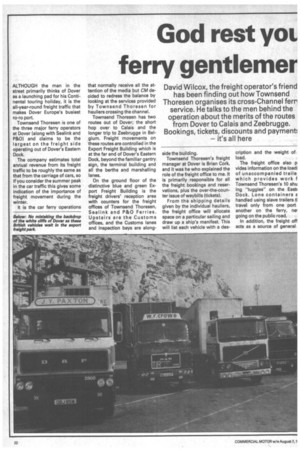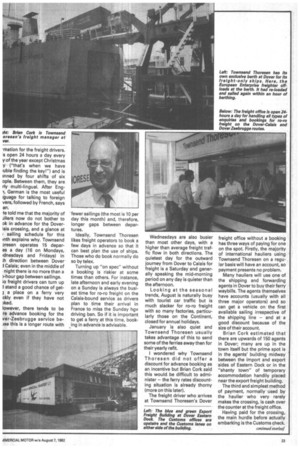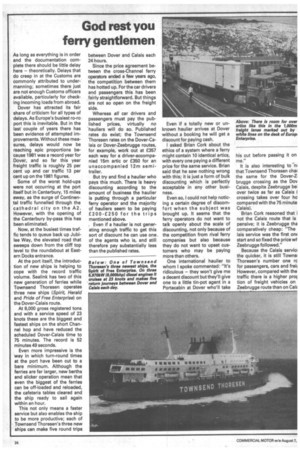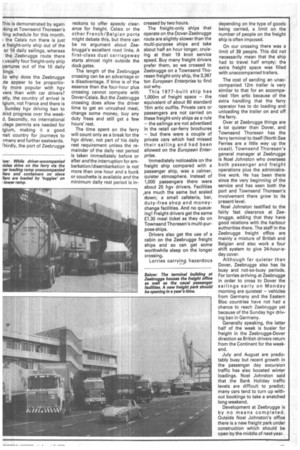God rest yoL ferry gentlemer
Page 18

Page 19

Page 20

Page 21

If you've noticed an error in this article please click here to report it so we can fix it.
David Wilcox, the freight operator's friend has been finding out how Townsend Thoresen organises its cross-Channel ferr service. He talks to the men behind the operation about the merits of the routes from Dover to Calais and Zeebrugge. Bookings, tickets, discounts and payment: — it's all here
ALTHOUGH the man in the street primarily thinks of Dover as a launching pad for his Continental touring holiday, it is the all-year-round freight traffic that makes Dover Europe's busiest ro-ro port.
Townsend Thoresen is one of the three major ferry operators at Dover (along with Sealink and P&O) and claims to be the largest on the freight side operating out of Dover's Eastern Dock.
The company estimates total annual revenue from its freight traffic to be roughly the same as that from the carriage of cars, so if you consider the summer peak in the car traffic this gives some indication of the importance of freight movement during the winter.
It is the car ferry operations
that normally receive all the attention of the media but CM decided to redress the balance by looking at the services provided by Townsend Thoresen for hauliers crossing the channel.
Townsend Thoresen has two routes out of Dover; the short hop over to Calais and the longer trip to Zeebrugge in Belgium. Freight movements on these routes are controlled in the Export Freight Building which is at the far end of Dover's Eastern Dock, beyond the familiar gantry sign, the terminal building and all the berths and marshalling lanes.
On the ground floor of the distinctive blue and green Export Freight Building is the freight drivers' reception area with counters for the freight offices of Townsend Thoresen, Sealink and P&O Ferries. Upstairs are the Customs offices, and the Customs lanes and inspection bays are along side the building.
Townsend Thoresen's freight manager at Dover is Brian Cork, and it was he who explained the role of the freight office to me. It is primarily responsible for all the freight bookings and reservations, plus the over-the-counter issue of waybills (tickets).
From the shipping details given by the individual hauliers, the freight office will allocate space on a particular sailing and draw up a ship's manifest. This will list each vehicle with a des cription and the weight of load.
The freight office also p vides information on the loadi of unaccompanied traile which provides work f Townsend Thoresen's 10 shu ing "tuggies" on the East4 Dock. Lone containers a handled using slave trailers ti travel only from one port another on the ferry, ne, going on the public road.
In addition, the freight off acts as a source of general .mation for the freight drivers. s open 24 hours a day every y of the year except Christmas y ("that's when we have uble finding the key!") and is inned by four shifts of six ople. Between them, they are rly multi-lingual. After Eng1, German is the most useful iguage for talking to foreign vers, followed by French, says an.
le told me that the majority of Jliers now do not bother to ok in advance for the Dovertais crossing, and a glance at sailing schedule for this inth explains why. Townsend aresen operates 15 depares a day (16 on Mondays, Idnesdays and Fridays) in 11 direction between Dover Calais; even in the middle of night there is no more than a )-hour gap between sail ings. lo freight drivers can turn up stand a good chance of get; a place on a ferry very ckly even if they have not )ked.
lowever, there tends to be re advance booking for the ver-Zeebrugge service beise this is a longer route with fewer sailings (the most is 10 per day this month) and, therefore longer gaps between departures.
Ideally, Townsend Thoresen likes freight operators to book a few days in advance so that it can best plan the use of ships. Those who do book normally do so by telex.
Turning up "on spec" without a booking is riskier at some times than others. For instance, late afternoon and early evening on a Sunday is always the busiest time for ro-ro freight on the Calais-bound service as drivers plan to time their arrival in France to miss the Sunday hgv driving ban. So if it is important to get a ferry at this time, booking in advance is advisable. Wednesdays are also busier than most other days, with a higher than average freight traffic flow in both directions. The quietest day for the outward journey from Dover to Calais for freight is a Saturday and generally speaking the mid-morning period on any day is quieter than the afternoon.
Looking at the seasonal trends, August is naturally busy with tourist car traffic but is much slacker for ro-ro freight with so many factories, particularly those on the Continent, closed for annual holidays.
January is also quiet and Townsend Thoresen usually takes advantage of this to send some of the ferries away then for their yearly refit.
I wondered why Townsend Thoresen did not offer a discount for advance booking as an incentive but Brian Cork said this would be difficult to administer — the ferry rates discounting situation is already thorny (more on this later).
The freight driver who arrives at Townsend Thoresen's Dover freight office without a booking has three ways of paying for one on the spot. Firstly, the majority of international hauliers using Townsend Thoresen on a regular basis will have an account, so payment presents no problem.
Many hauliers will use one of the shipping and forwarding agents in Dover to buy their ferry waybills. The agents themselves have accounts (usually with all three major operators) and so can get a vehicle on the first available sailing irrespective of the shipping line — and at a good discount because of the size of their account.
Brian Cork estimated that there are upwards of 150 agents in Dover; many are up in the town itself but the prime spot is in the agents' building midway between the import and export sides of Eastern Dock or in the "shanty town" of temporary accommodation handily placed near the export freight building.
The third and simplest method of payment, normally used by the haulier who very rarely makes the crossing, is cash over the counter at the freight office.
Having paid for the crossing, the main hurdle before actually embarking is the Customs check. As long as everything is in order and the documentation complete there should be little delay here — theoretically. Delays that do creep in at the Customs are commonly attributed to undermanning; sometimes there just are not enough Customs officers available, particularly for checking incoming loads from abroad.
Dover has attracted its fair share of criticism for all types of delays. As Europe's busiest ro-ro port this is inevitable. But in the last couple of years there has been evidence of attempted improvements. Without these measures, delays would now be reaching epic proportions because 1981 was a record year for Dover, and so far this year freight traffic is roughly 25 per cent up and car traffic 13 per cent up on the 1981 figures.
Some of the worst hold-ups were not occurring at the port itself but in Canterbury, 15 miles away, as the surge of Continental traffic funnelled through the cathedral city on the A2. However, with the opening of the Canterbury by-pass this has been eliminated.
Now, at the busiest times traffic tends to queue back up Jubilee Way, the elevated road that sweeps down from the cliff top level to the roundabout at Eastern Docks entrance.
At the port itself, the introduction of new ships is helping to cope with the record traffic volume. Sealink has two of this new generation of ferries while Townsend Thoresen operates three new ships (Spirit. Herald and Pride of Free Enterprise) on the Dover-Calais route.
At 8,000 gross registered tons and with a service speed of 23 knots these are the biggest and fastest ships on the short Channel hop and have reduced the scheduled Dover-Calais time to 75 minutes. The record is 52 minutes 49 seconds.
Even more impressive is the way in which turn-round times at the port have been cut to a bare minimum. Although the ferries are far larger, new berths and slicker operation mean that even the biggest of the ferries can be off-loaded and reloaded, the cafeteria tables cleared and the ship ready to sail again within an hour.
This not only means a faster service but also enables the ship to be more productive; each of Townsend Thoresen's three new ships can make five round trips between Dover and Calais each 24 hours.
Since the price agreement between the cross-Channel ferry operators ended a few years ago, the competition between them has hotted up. For the car drivers and passengers this has been fairly straightforward. But things are not so open on the freight side.
Whereas all car drivers and passengers must pay the published prices, virtually no hauliers will do so. Published rates do exist; the Townsend Thoresen rates on the Dover-Calais or Dover-Zeebrugge routes, for example, work out at 057 each way for a driver-accompanied 15m artic or E350 for an unaccompanied 12m semitrailer.
But try and find a haulier who pays this much. There is heavy discounting according to the amount of business the haulier is putting through a particular ferry operator and the majority of hauliers seem to be paying 200-£250 for the trips mentioned above.
. Even if a haulier is not generating enough traffic to get this sort of discount he can use one of the agents who is, and still therefore pay substantially less than the published rates. Even if a totally new or unknown haulier arrives at Dover without a booking he will get a discount for paying cash.
I asked Brian Cork about the ethics of a system where a ferry might contain 10 identical artics, with every one paying a different price for the same service. Brian said that he saw nothing wrong with this; it is just a form of bulk discounting which is perfectly acceptable in any other business.
Even so, I could not help noticing a certain degree of discomfort when the subject was brought up. It seems that the ferry operators do not want to talk openly about the scale of discounting, not only because of the competition from rival ferry companies but also because they do not want to upset customers who may be paying more than others.
One international haulier to whom I spoke commented: "It's ridiculous — they won't give me a decent discount but they'll give one to a little tin-pot agent in a Portacabin at Dover who'll take his cut before passing it on me."
It is also interesting to nr that Townsend Thoresen char the same for the Dover-Z' brugge crossing as the Dov Calais, despite Zeebrugge bei over twice as far as Calais ( crossing takes over four ho compared with the 75 minute. Calais).
Brian Cork reasoned that i not the Calais route that is pensive; it is Zeebrugge tha comparatively cheap: "The lais service was the first on start and so fixed the price Zeebrugge followed."
Because the Calais servici the quicker, it is still Townsi Thoresen's number one rc for passengers, cars and freii However, compared with the traffic there is a higher proj tion of freight vehicles on .Zeebrugge route than on Cali
fills is demonstrated by again aking at Townsend Thoresen's ling schedule for this month. the Calais run there is just e freight-only ship out of the or 16 daily sailings, whereas the Zeebrugge route there usually four freight-only ship partures out of the 10 daily lings.
3o why does the Zeebrugge Jte appear to be proportioIly more popular with hgv vers than with car drivers? shy, the country of arrival is !glum, not France and there is Sunday hgv driving ban to ;trict progress over the weekJ. Secondly, no international ulage permits are needed for lgium, making it a good nsit country for journeys to rmany and further eastwards. Thirdly, the port of Zeebrugge reckons to offer speedy clearance for freight. Calais or the other French/Belgian ports might debate this, but there can be no argument about Zeebrugge's excellent road links. A first-class dual carriageway starts almost right outside the dock gates.
The length of the Zeebrugge crossing can be an advantage or a disadvantage. If time is of the essence then the four-hour plus crossing cannot compete with Dover-Calais. But the Zeebrugge crossing does allow the driver time to get an unrushed meal, change some money, buy any duty frees and still get a few hours' rest.
The time spent on the ferry will count only as a break for the hgv driver, not part of his daily rest requirement unless the remainder of the daily rest period is taken immediately before or after andthe interruption for embarkation/disembarkation is not more than one hour and a bunk or couchette is available and the minimum daily rest period is in
creased by two hours.
The freight-only ships that operate on the Dover-Zeebrugge route are slightly slower than the multi-purpose ships and take about half an hour longer, cruising at their 19 knot service speed. Buy many freight drivers prefer them, so we crossed to Zeebrugge on a Townsend Thoresen freight-only ship, the 3,367 ton European Enterprise to find out why.
This 1 97 7-built ship has 1,000m of freight space — the equivalent of about 60 standard 15m artic outfits. Private cars or passengers are not carried on these freight-only ships as a rule — the sailings are not advertised in the retail car-ferry brochures — but there were a couple of private cars which had missed their sailing and had been allowed on the European Enterprise.
Immediately noticeable on the freight ship compared with a passenger ship, was a calmer, quieter atmosphere. Instead of 1,000 passengers there were about 25 hgv drivers. Facilities ,are much the same but scaled down; a small cafeteria, bar, duty-free shop and moneychange facilities. And no queueing! Freight drivers get the same £1.30 meal ticket as they do on Townsend Thoresen's multi-purpose ships.
Drivers also get the use of a cabin on the Zeebrugge freight ships and• so can get some worthwhile sleep on the longer crossing.
Lorries carrying hazardous depending on the type of goods being carried, a limit on the number of people on the freight ship is often imposed.
On our crossing there was a limit of 39 people. This did not necessarily mean that the ship had to travel half empty; the extra freight space was filled with unaccompanied trailers.
The cost of sending an unaccompanied 12m trailer is very similar to that for an accompanied 15m artic because of the extra handling that the ferry operator has to do loading and unloading the trailer on and off the ferry.
Over at Zeebrugge things are a lot quieter than Dover, and Townsend Thoresen has the ferry terminal to itself (North Sea Ferries are a little way up the coast). Townsend Thoresen's general manager at Zeebrugge is Noel Johnston who oversees both passenger and freight operations plus the administrative work. He has been there since the very beginning of the service and has seen both the port and Townsend Thoresen's involvement there grow to its present level.
Noel Johnston testified to the fairly fast clearance at Zeebrugge, adding that they have good relations with the harbour authorities there. The staff in the Zeebrugge freight office are mainly a mixture of British and Belgian and also work a four shift system to give 24-hour-aday cover.
Although far quieter than Dover, Zeebrugge also has its busy and not-so-busy periods. For lorries arriving at Zeebrugge in order to cross to Dover the sailings early on Monday morning are quietest — vehicles from Germany and the Eastern Bloc countries have not had a chance to reach Zeebrugge yet because of the Sunday hgv driving ban in Germany.
Generally speaking, the latter half of the week is busier for freight in the Zeebrugge-Dover direction as British drivers return from the Continent for the weekend.
July and August are predictably busy but recent growth in the passenger day excursion traffic has also boosted winter loadings. Noel Johnston said that the Bank Holiday traffic levels are difficult to predict; many cars tend to turn up without bookings to take a snatched long weekend.
Development at Zeebrugge is by no means completed. Outside Noel Johnston's office there is a new freight park under construction which should be open by the middle of next year.






















































